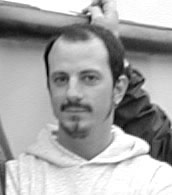 Pat Iampietro is a hydrographer/research associate who works for the Seafloor Mapping Lab at California State University Monterey Bay (CSUMB). His job involves planning, designing, and implementing hydro-acoustic surveys at depths of up to 300 meters in order to get a good understanding of seafloor habitats in the survey areas.
Pat Iampietro is a hydrographer/research associate who works for the Seafloor Mapping Lab at California State University Monterey Bay (CSUMB). His job involves planning, designing, and implementing hydro-acoustic surveys at depths of up to 300 meters in order to get a good understanding of seafloor habitats in the survey areas.
Iampietro’s work requires an excellent understanding, both mechanically and functionally, of a wide range of technologies. These include side-scan sonar, single-beam depth sounder, multi-beam bathymetry, GIS (geographic information systems), GPS (global positioning systems), motion compensators, ROV technology, and SCUBA. In addition, he must be able to work with three general types of software: data acquisition, data processing, and GIS analysis. He works both at sea and in the laboratory.
"Being outside in the natural environment and seeing great places and neat critters – that makes this job great"
“Fieldwork is both mentally and physically demanding, due to the long hours and variable weather and sea conditions,” explains Iampietro. While at sea, the work day starts as early as 4:30 a.m. Days are spent mapping the ocean bottom, which involves driving the research vessel back and forth over the survey area with sonar running. At the end of day, the data gathered are downloaded from the computers where they were logged. Typically, some technicians stay on shore each day and process the data from the day before, so the researchers can use the information to plan activities for the rest of the trip.
Back at CSUMB, laboratory work entails maintaining equipment, processing data, and writing reports. “We almost always need to process data further after a cruise,” Iampietro says. This involves creating various data sets and doing a lot of GIS work. “Most of what we do is aimed at quantifying or analyzing habitat – for fish, invertebrates, or kelp, for example,” he explains. “So we’ll do analysis of the substrate, slopes – that sort of thing.”
Iampietro believes that problem solving is the most important skill for his job. “We work with temperamental equipment, multiple sensors that have to work together, and complex systems,” he explains. “Critical thinking and attacking a problem logically are the only way to get the job done.”
"Fieldwork is both mentally and physically demanding, due to the long hours and variable weather and sea conditions"
Iampietro has a B.S. in marine biology, an M.S. in marine science, and an Open Water II SCUBA certification. A lot of the work he does has been self-taught or learned on the job, however. This is partly because he wasn’t aiming directly for this career; but even if he had been, he believes that formal training for the work hydrographic surveyors do just wasn’t available when he was in school. (“Thanks to the MATE Center, that’s changing,” he adds.)
According to Iampietro, the best parts of his job are the excitement of fieldwork and access to new technology (although that can be a two-edged sword, because the technology can be frustrating, too). “Being outside in the natural environment and seeing great places and neat critters – that makes this job great,” he says.
<< Back to Profiles Start Page
|
|
